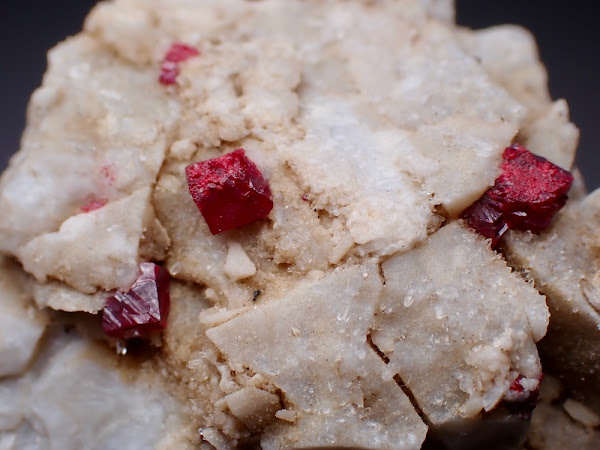ウッツの辰砂 Cinnabar from Uttsu
赤い辰砂の微結晶が鉱脈中に散りばめられる。劈開面がキラキラ光る。辰砂(HgS)の比重は 8.1 で石英の 3 倍の重さだが、この鉱石片は見た目ほど重くないので、辰砂がパンパンに充満しているわけではなさそうだ。とはいえ相当高品位の水銀鉱石である。
北海道には数多くの水銀鉱床があった。もっとも規模が大きかったのが北見市(旧留辺蘂町)のイトムカ鉱山で、ここは自然水銀がおもな鉱石(鉱滴?)だったことでも有名である。ウッツの水銀鉱床は1940年代に発見され、一時休山していたものを、野村鉱業(現・野村興産)がイトムカの支山として再開発し、1963年まで稼行した。
Minute red crystals of cinnabar with twinkling cleavage faces are embedded in a vein. As this piece is not so heavy, cinnabar would not occupy the volume very much. However, this is quite a high quality mercury ore. There were many mercury deposits in Hokkaido. The biggest one was Itomuka (Kitami City, former Rubeshibe Town), which was unique in that the main ore was native mercury. The Uttsu mine was found in 1940s and operated by Nomura Mining Company as a secondary ore field of Itomuka until 1963.
参考
-
野村興産のページ。1939年頃よりイトムカ鉱山の開発に着手し、以後30年以上にわたって水銀を生産した。当地では廃棄物から水銀を回収・リサイクルするプラントが現在も稼働中である。
Nomura Kohsan Company operated the Itomuka Mine for more than 30 years since 1939. A mercury recycling plant is still ongoing at the same place.
-
常呂郡置戸町旭鉱山の辰砂。ここも小規模な水銀鉱山だった。この標本は鉱山稼働時のものというよりは、むしろ後年鉱山周辺の紅の沢と称される区域で愛鉱家が採集したものだろう。品位は低いが、日本産としては結晶サイズが大きい。
Cinnabar from Asahi Mine, Oketo Town, Hokkaido. Asahi was also a small mercury mine. This piece was probably collected from Beninosawa after the closure of the Asahi mine, which is well known among Japanese mineral collectors because of large crystals.
結晶サイズは約 3 mm。 The crystal size is about 3 mm.



